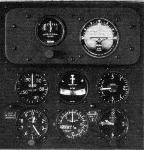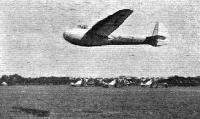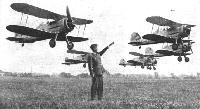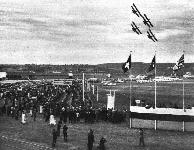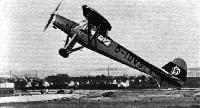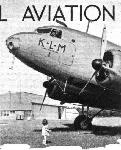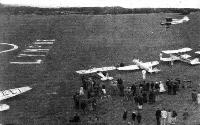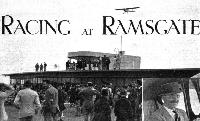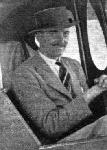Фотографии
-
Регистрационный номер: URSS-N025-1 PIONEER: The Russian A.N.T.25 (950 h.p. M.34) which lately captured the world's long-distance record by flying for about 6,650 miles in 62 hours. This is the world's largest single-engined aircraft. Despite the 947 sq. ft. of wing area the take-off occupied 2,000 yds.
Самолёты на фотографии: Туполев, Сухой АНТ-25 / РД - Россия - 1933
-
THE CULT OF THE INVERTED VEE: The Daimler-Benz and Junkers concerns have lately built inverted-vee liquid-cooled engines for new German military machines. On the left is a D-B installation in a B.F.W. 109 while the right-hand view shows a similar machine with a Junkers.
Самолёты на фотографии: Messerschmitt Bf.109 / Bf.109B / Bf.109C / Bf.109D - Германия - 1935
-
L'entente Cordiale: Col. Udet explains some of the finer points of the new B.F.W. Me. 109 monoplane fighter to a French visitor, M. Cambois. Standing alongside is Fraulein Liesel Bach, who put up a brilliant show in one of the aerobatics competitions.
Самолёты на фотографии: Messerschmitt Bf.109 / Bf.109B / Bf.109C / Bf.109D - Германия - 1935
-
AND AT HOME IN ENGLAND: The Maharajah of Nawanagar, accompanied by the Maharanee, visited the R.A.F. Station at Abingdon. Seen in front of a Bristol Blenheim are (left to right): Wing Comdr. C. E. W. Lockyer, Mrs. Guilfoyle, Air Comdre. Sidney Smith, O.B.E. (A.O.C. No. 1 Bomber Group, who received the visitors), the Maharajah, Mrs. Sidney Smith, P/O. Hull, the Maharanee, Mr. W. Rootes, P/O. Kemp, Mrs. Edelsten, Group Capt. Guilfoyle, O.B.E., M.C., Mrs. Walmsley, Miss Smith, and Wing cdr. H. S. P. Walmsley, O.B.E., M.C., D.F.C. The visitors saw demonstrations by Blenheims and by Hawker Hinds of No. 82 (B.) Squadron.
Самолёты на фотографии: Bristol Blenheim - Великобритания - 1936
-
The Italians put up an original formation aerobatic show on Fiat C32 biplanes, one of which is seen here. Note the long aileron mass balances.
Самолёты на фотографии: FIAT CR.30 / CR.32 Chirri - Италия - 1932
-
A line-abreast formation of Italian fighters skating along at outrageous angles on their sides.
Самолёты на фотографии: FIAT CR.30 / CR.32 Chirri - Италия - 1932
-
Регистрационный номер: HB-IRA One of Swissair's two Douglas D.C.3s with the Dubendorf terminal building in the background. Behind the tail of the machine is the open-air public restaurant.
Самолёты на фотографии: Douglas DC-3 / C-47 Skytrain/С-53 Skytrooper / Dakota - США - 1935
-
Регистрационный номер: D-EMUN A Klemm and a Junkers Ju. 52 (the latter used to transport officials and mechanics), with Mr. W. Welton's B.A. Eagle behind, before the massive hangar at Orly.
Самолёты на фотографии: British Klemm BK-1 Eagle - Великобритания - 1934Junkers Ju.52/3m - Германия - 1931Klemm Kl.35 / Kl.106 - Германия - 1935
-
Two of the Savoias and the pair of Fiats. The Savoia in the immediate foreground is the actual winner. The engines are understood to be of the Bristol Pegasus type built under licence and, as may be seen, have the latest type of Bristol cowling.
Самолёты на фотографии: FIAT BR.20 Cicogna - Италия - 1936Savoia-Marchetti / SIAI SM.79 Sparviero - Италия - 1934
-
Italy bases her hopes on a trio of Savoia-Marchetti S.70s which are believed to have three Pegasus-type engines built under licence by Alfa Romeo.
Самолёты на фотографии: Savoia-Marchetti / SIAI SM.79 Sparviero - Италия - 1934
-
Регистрационный номер: K7558 [2] Battle K7558 was the first production aircraft and was sent to both Martlesham Heath and Farnborough for evaluation. In August 1940 it was damaged beyond repair in a forced landing near Tiverton, Devon.
Самолёты на фотографии: Fairey Battle - Великобритания - 1936
-
Регистрационный номер: K7558 [2] Manoeuvrability has not been sacrificed to performance, as indicated in this picture of the Battle in a vertical bank. The pilot is Flt. Lt. C. S. Staniland, Fairey's chief test pilot.
Самолёты на фотографии: Fairey Battle - Великобритания - 1936
-
Самолёты на фотографии: Fairey Battle - Великобритания - 1936
-
Structural details of Fairey "Battle"
Самолёты на фотографии: Fairey Battle - Великобритания - 1936
-
Самолёты на фотографии: Fairey Battle - Великобритания - 1936
-
Регистрационный номер: G-ADHK [3] THE BETTER HALF - or, at least, the larger portion of the Short-Mayo composite. Basically an Empire boat, Maia has flared-out chines to give better stability on the water when carrying her seaplane, the inboard Pegasus engines are set farther out from the hull to clear the float plane's under-carriage and fixed-pitch airscrews, doubtless designed for efficiency at take-off are fitted.
Самолёты на фотографии: Short Mayo Composite (S.20 Mercury and S.21 Maia) - Великобритания - 1938
-
Регистрационный номер: G-ADHK [3] In Home Waters: The lower component of the Short-Mayo composite aircraft, the Maia, on the Medway off Short's works. Note the supports for the upper component.
Самолёты на фотографии: Short Mayo Composite (S.20 Mercury and S.21 Maia) - Великобритания - 1938
-
Регистрационный номер: G-ADHK [3] Piloted by Mr. Lankester Parker, the upper component of the Short Mayo Composite aircraft is now going through its flight tests.
Самолёты на фотографии: Short Mayo Composite (S.20 Mercury and S.21 Maia) - Великобритания - 1938
-
Регистрационный номер: G-ADHJ Mercury, the upper component, is nearing completion at Rochester and should be flying this month.
Самолёты на фотографии: Short Mayo Composite (S.20 Mercury and S.21 Maia) - Великобритания - 1938
-
One of the Fiat BR 20 As, which like the Savoia-Marchettis, are adaptions of a bomber type.
Самолёты на фотографии: FIAT BR.20 Cicogna - Италия - 1936
-
Регистрационный номер: K4766 Now each University Squadron has some Harts in addition to its Tutors. Three Oxford Harts are seen flying along the South Coast.
Самолёты на фотографии: Hawker Hart - Великобритания - 1928
-
Several slower machines had already taken off when Mr. E. F. Walter was snapped with his Miles Hawk. Tommy Rose may be seen chatting near the B. A. Eagle.
Самолёты на фотографии: British Klemm BK-1 Eagle - Великобритания - 1934Miles Hawk / M.2 - Великобритания - 1932
-
OUT OF THE SUN: A Lockheed Twelve dives past the machine park during a recent display at Vancouver. In the foreground is a visiting Supermarine Walrus, which startled everyone by its agility.
Самолёты на фотографии: Lockheed Electra Junior 12 - США - 1936Supermarine Walrus/Seagull V - Великобритания - 1933
-
The Koolhoven F.K.26 is one of a number of pioneer types and was obtained from a source apparent in this photograph of the machine being shipped to Holland some little time back.
Самолёты на фотографии: BAT FK-26 Commercial - Великобритания - 1919
-
A typical American array of a few years ago, used on the Boeing 247s. Above is the Sperry free gyro panel, while below, from left to right, can be seen (top row) an A.S.I., a turn and bank indicator, and a rate-of-climb indicator, and (bottom row) a sensitive altimeter, a boost gauge, and a clock.
Самолёты на фотографии: Boeing Model 247 - США - 1933
-
THE CULT OF THE INVERTED VEE: The Daimler-Benz and Junkers concerns have lately built inverted-vee liquid-cooled engines for new German military machines. The twin-engined bomber is a Dornier Do.17 with two Daimler-Benz engines.
Самолёты на фотографии: Dornier Do.17 - Германия - 1934
-
D/L? This picture of the Focke-Wulf helicopter suggests that the familiar ratio of lift to drag may have to be reversed in importance. Some years ago this German firm obtained rights in the Cierva Autogiro, but the new machine is a complete departure. It recently broke all the world's helicopter records (including a speed of 76 m.p.h., height of over 8,000 ft., and duration of 1h. 20m.) and it definitely is able to rise and descend vertically.
Самолёты на фотографии: Focke-Wulf FW.61 - Германия - 1936
-
Mr. Nicholson took advantage of the wind to show some of the capabilities of his Rhonsperber glider.
Самолёты на фотографии: DFS Rhonsperber / Sperber Senior / Sperber Junior - Германия - 1935
-
Регистрационный номер: K7923, K7930, K7931 "Audax Omnia Perpeti." Gloster Gladiators of No. 54 (Fighter) Squadron take off from Hornchurch in fine style.
Самолёты на фотографии: Gloster Gladiator - Великобритания - 1934
-
The four Hawker Furies in their famous diamond formation.
Самолёты на фотографии: Hawker Fury - Великобритания - 1931
-
THE R.A.F. AT ZURICH. Four Furies of No. 1 Fighter Squadron give their R.A.F. Display demonstration over Dubendorf aerodrome.
Самолёты на фотографии: Hawker Fury - Великобритания - 1931
-
An order for Pegasus - engined T.V bombers has been placed by the Netherlands Government with Fokker. The machines are seen here under construction.
Самолёты на фотографии: Fokker T.V - Нидерланды - 1937
-
Регистрационный номер: F-APUZ The Farman attempted to fly the whole course nonstop but landed at Belgrade.
Самолёты на фотографии: Farman/SNCAC NC.223 - Франция - 1937
-
Регистрационный номер: D-IDVS SAFETY FIRST: The Fieseler Stork, which appeared at the Zurich Meeting, in a characteristic attitude With fixed, full-length slots and flaps, the Stork has a fully controlled stalled glide at an air speed of 24 m.p.h. and the undercarriage is designed to take a vertical velocity of 15 ft./sec. The standard power unit is the 240 h.p. Argus vee-eight, giving the machine a maximum speed of 130 m.p.h. The three occupants are seated in tandem.
Самолёты на фотографии: Fieseler Fi.156 Storch - Германия - 1936
-
ACHIEVEMENT: An inspiring view of Vought Corsairs over the Golden Gate Bridge, San Francisco. This structure is claimed to be the world's longest suspension bridge and was opened to traffic a few weeks ago.
Самолёты на фотографии: Vought O2U/O3U/V-65/V-93 Corsair - США - 1926
-
A GOOD CRUISE: The London flying boats of No. 204 (F.B.) Squadron at Malta, on their recent cruise from Plymouth to the Mediterranean.
Самолёты на фотографии: Saunders-Roe London / A.27 - Великобритания - 1934
-
In the foreground of this general view are the Bucker and Klemm exhibits. The Fokker C11W seaplane is in the distance.
Самолёты на фотографии: Bucker Bu.131 Jungmann - Германия - 1934Fokker C.XI-W - Нидерланды - 1935Klemm Kl.35 / Kl.106 - Германия - 1935
-
The first of the new Vought scout-bombers (P. and W. Twin Wasp Junior) designed for operation from carriers. It may be used for reconnaisance or dive bombing with a 1,000 or 500 lb. bomb. Note the excellent fine view obtainable from the pilot's cockpit.
Самолёты на фотографии: Vought SB2U Vindicator / V-156 - США - 1936
-
A BOMBER'S BRIDGE: The pilot's cockpit of a Handley Page Harrow Mk. II heavy bomber, showing the location of the flying controls, including the long operating lever for the Dowty flap gear, and the Hobson mixture and throttle controls associated with the twin Pegasus XX fully supercharged radials.
Самолёты на фотографии: Handley Page Harrow / H.P.54 - Великобритания - 1936
-
Регистрационный номер: D-EEHO The new Focke-Wulf twin-engined trainer with the little Bucker Jungmeister - a type used for much of the aerobatic work during the Zurich meeting.
Самолёты на фотографии: Bucker Bu.133 Jungmeister - Германия - 1935Focke-Wulf FW.58 Weihe - Германия - 1935
-
Самолёты на фотографии: Douglas DC-1 / DC-2 / C-32 / C-39 - США - 1933
-
Регистрационный номер: K3274 Members of the C.U.A.S. and their instructors. Second from the left is the Chief Instructor, Wing Cdr. Lockyer, and fourth is the C.F.I., Sqn. Ldr. Mason.
Самолёты на фотографии: Avro Tutor/Sea Tutor/Prefect / Type 621/646/626 - Великобритания - 1929
-
GOOD HUNTING: Anti-aircraft gunners gave the lie to those who say that they will have only a moral effect on air raiders, when the 171st Battery, 61st A.A. Brigade R.A., Territorial Army, formerly known as the Finsbury Rifles, shot down a Queen Bee at their camp at Watchet, Somerset, on August 13. The Queen Bee, developed from the Tiger Moth, is a target aeroplane, controlled by wireless. They were intended for use by the Fleet, but this year they have been supplied for use by the Army too. As shown in these exclusive photographs, this one was catapulted into the air and she rose to 4,000 feet over the Bristol Channel. She was about a mile off when two A.A. guns opened fire, and the third volley hit her behind the engine. At first it was feared that she might crash on to the Battery, but she came down in the sea. The Gipsy Major engine broke loose and sank, but the fuselage and portions of the wings were salvaged.
Самолёты на фотографии: De Havilland Queen Bee / D.H.82B - Великобритания - 1935
-
Регистрационный номер: G-ADHL ON the river Nile at Malakal, the terminal port for the Imperial Airways flying boats in the Anglo-Egyptian Sudan, large islands of floating papyrus (Cyperus Papyrus) and Um Soof (Vossia Procera) are encountered between May and September. This seasonal scourge is caused by the fact that the floods from the great lakes loosen the roots of the vegetation in the swampy areas farther south. Eventually, large sections break away from the main mass and drift slowly downstream, a menace to flying boats. The photograph shows Canopus safely moored with the floating islands drifting past.
Самолёты на фотографии: Short Empire / S.23 - Великобритания - 1936
-
Between heats and final mechanics tinkered, while spectators watched demonstrations of the Wicko, seen flying above, the Porterfield "70" and the German Fieseler with 70 h.p. Hirth engine.
Самолёты на фотографии: Fieseler F-4 / F-5 - Германия - 1933Foster Wikner Wicko - Великобритания - 1936Porterfield 35 Flyabout - США - 1936
-
Регистрационный номер: G-AEUP Natural curiosity
Самолёты на фотографии: Praga E-114 Air Baby / E-115 / E-117 - Чехословакия - 1934
-
Powered with four Hispano Series X engines of 720 h.p. each, the Marcel Bloch 160 has only very recently completed its tests. The radiator arrangements should be compared with those of the Farman.
Самолёты на фотографии: Bloch MB.160 Languedoc - Франция - 1937
-
Регистрационный номер: F-APDY The Breguet Fulgur in the foreground came fifth, averaging 182 m.p.h. Seventh place was secured by the big Bloch 160 in the background.
Самолёты на фотографии: Bloch MB.160 Languedoc - Франция - 1937Breguet Br.470 Fulgur - Франция - 1936
-
Регистрационный номер: F-IMEO The striking Focke-Wulf advanced trainer which has an unusual tail unit.
Самолёты на фотографии: Focke-Wulf FW.56 Stosser - Германия - 1933
-
An unusual tail unit of the Focke-Wulf advanced trainer.
Самолёты на фотографии: Focke-Wulf FW.56 Stosser - Германия - 1933
-
Регистрационный номер: YL-ABG The fascinating little Latvian V.E.F. 12 which was judged the smartest machine on parade.
Самолёты на фотографии: Irbitis, VEF I-11 / I-12 / I-17 - Латвия - 1936
-
PUSHER PURSUIT: Designed to attack anything in the air or on the ground this new American Bell monoplane has pusher airscrews driven by liquid-cooled Allison engines and is armed with a pair of cannons. It is a very brave effort for a new company and should provide a good deal of welcome data
Самолёты на фотографии: Bell FM-1 Airacuda - США - 1937
-
Регистрационный номер: YR-AHA Captain Papana's Bellanca has a Fairchild Ranger inverted vee-twelve in the nose and two Menasco Buccaneers in wing nacelles.
Самолёты на фотографии: Bellanca 28-92 - США - 1937
-
FOWLER-FLAPPED: The first photographs of the new Lockheed 14, or Super-Electra, transport. It will be noted that although this machine bears the "X" licence markings it carries the insignia of Northwest Airlines. Points of technical interest include the Fowler flaps, the shape of the fuselage (in particular the nose) and the tail unit, the latter of a type which has given such encouraging results on the Electra and "12."
Самолёты на фотографии: Lockheed Super Electra 14 - США - 1937
-
Mr. Elwell brings his victorious Cub in over the attractive clubhouse at Ramsgate.
Самолёты на фотографии: Taylor Cub - США - 1931
-
A detailed view of Mr. Elwell.
Самолёты на фотографии: Taylor Cub - США - 1931
-
Регистрационный номер: G-ACSS [4] The D.H. Comet is now fitted with two Series II Gipsy Sixes. It came fourth in the recent Damascus race.
Самолёты на фотографии: De Havilland Comet / D.H.88 - Великобритания - 1934
-
Регистрационный номер: G-ACSS [4] The same aircraft, now named The Orphan and flown in the 1937 Damascus - Paris race by Clouston and George Nelson.
Although the Comet is three years old it is still remarkable for the high speed it can maintain over long distances. As will be seen, no major alterations have been made to the The Orphan.Самолёты на фотографии: De Havilland Comet / D.H.88 - Великобритания - 1934
-
Регистрационный номер: G-ACSS [4] The Orphan's guardians. F/O Clouston (right) is the pilot and Flt. Lt. Nelson, his companion, will navigate.
Самолёты на фотографии: De Havilland Comet / D.H.88 - Великобритания - 1934
-
Регистрационный номер: G-ACSS [4] The installation of the Series II Gipsy Six engines.
Самолёты на фотографии: De Havilland Comet / D.H.88 - Великобритания - 1934
-
Регистрационный номер: G-AEXX, L7270 THE KING'S ENVOY: One of the first flying views of the specially prepared Airspeed Envoy Series III (two Armstrong Siddeley Cheetah Xs) which is maintained for the transport of Royalty and State personages. The top speed is over 200 m.p.h. This particular machine belongs to the King’s Flight.
Самолёты на фотографии: Airspeed Envoy / AS.6 - Великобритания - 1934
-
SUB-STRATOSPHERE EXPERIMENT: The special Lockheed ordered by the U.S Army Air Corps for experimental work at high altitudes. Note the exhaust-driven superchargers behind the cowlings of the Wasp engines. The machine is basically similar to an Electra but has a pressure cabin
Самолёты на фотографии: Lockheed C-35 - США - 1936
-
WITH a view to collecting data on the operation of long-range aircraft at extreme altitudes the U.S, Army Air Corps has acquired a special Lockheed monoplane based on the Electra. The engines are believed to be Pratt and Whitney Wasps and have turbo-blowers. The view shows the cockpit at the forward end of the pressure cabin with the emergency oxygen supply on the right.
Самолёты на фотографии: Lockheed C-35 - США - 1936
-
The special door in the rear bulkhead
Самолёты на фотографии: Lockheed C-35 - США - 1936
-
Some of the controls and dials on the technician's panel
Самолёты на фотографии: Lockheed C-35 - США - 1936
-
A GREAT EXPERIMENT: A group of the new YB-17 Boeing bombers (four 850 h.p. Wright Cyclone Gs) of the first batch of thirteen delivered to the U.S. Army Air Corps. A second order, for a similar number, has been placed. These machines are the first high-speed, four-engined bombers to enter the service of any nation, and their design forms the basis for the new civil transport landplanes under construction at the Boeing factory.
Самолёты на фотографии: Boeing B-17 Flying Fortress - США - 1935
-
Регистрационный номер: PH-KGH The Dutch De Schelde with Gypsy Major engine was unfortunately eliminated in the heats. The German Fieseler F.5.R., seen nearer to the hangar, suffered a similar fate.
Самолёты на фотографии: De Schelde S.12 - Нидерланды - 1937Fieseler F-4 / F-5 - Германия - 1933
-
Регистрационный номер: G-AEMA [2] THE CYGNET MAJOR: The new C.W. Cygnet with a Gipsy Major engine, shown here in the act of being taken off by Mr. Wynne-Eaton at Hanworth, is one of the King's Cup entries. In the race the machine, which has been modified in certain details, will be flown by Mr. Charles Hughesdon.
Самолёты на фотографии: C.W. Aircraft Cygnet - Великобритания - 1937
-
Регистрационный номер: G-AEMA [2] FOR THE KING'S CUP: The redesigned cabin and new moulded windscreen certainly improve the appearance of the Cygnet Major, which is now flying at Hanworth. In the cabin are Messrs. Waddington (nearest the camera) and Wynne-Eaton, who is carrying out the tests.
Самолёты на фотографии: C.W. Aircraft Cygnet - Великобритания - 1937
-
VEST-POCKET VELOCITY: One of the first pictures of the new T.K.4 racing monoplane, designed and built by students of the De Havilland Technical School. It is only 19ft. 8in. in span and 15ft. 6in. in length. Fitted with the new Gipsy Major Series II engine and D.H. v.p. airscrew, it has been designed for a speed of 215 m.p.h. and, entered by Lord Wakefield, is to compete in the King's Cup Race. It is seen in an unpainted condition.
Самолёты на фотографии: De Havilland Technical School T.K.4 - Великобритания - 1937
-
Самолёты на фотографии: De Havilland Technical School T.K.4 - Великобритания - 1937
-
Although the wing area of the T.K.4 is quite astoundingly small the landing speed should be kept within reasonable limits by the slots and flaps.
Самолёты на фотографии: De Havilland Technical School T.K.4 - Великобритания - 1937
-
STABLE TALK: Mr. Bob Waite (pipe in mouth), who will fly the T.K.4 in the King's Cup Race, discussing some of the finer points of his mount at the D.H. Technical School.
Самолёты на фотографии: De Havilland Technical School T.K.4 - Великобритания - 1937
-
A special nose cowling has been developed for the T.K.4, and may be seen to advantage in the photograph in the heading. The duct, visible within the main intake, is for the carburettor air. Note also the diminutive wheels and undercarriage. The accompanying drawings reveal the extensive application of balsa wood in the structure of the T.K.4 and a number of other features of this unusual little aeroplane.
Самолёты на фотографии: De Havilland Technical School T.K.4 - Великобритания - 1937
-
With two Hispano-Suiza Series Y engines of 860 h.p. each, the Amiot 370, which has lately made its first flights, is estimated to be capable of 295 m.p.h.
Самолёты на фотографии: Amiot Amiot 370 - Франция - 1937
-
The main fuel load of the Amiot is carried in the fuselage, as shown, although additional tankage is provided in the wings.
Самолёты на фотографии: Amiot Amiot 370 - Франция - 1937
-
The Air-Couzinet 10 is a possible starter. It has a pair of Hispano-built Wright Cyclones with constant-speed airscrews. The pilot will be Dubourdieu.
Самолёты на фотографии: Couzinet Air Couzinet 10 / AC 10 - Франция - 1937
-
The Couzinet monoplane has unusual accommodation for the pilot, and is powered by two direct-drive radials. It seems to be of wooden construction.
Самолёты на фотографии: Couzinet Air Couzinet 10 / AC 10 - Франция - 1937
Статьи
- Flight
- Flight Advertisements
























